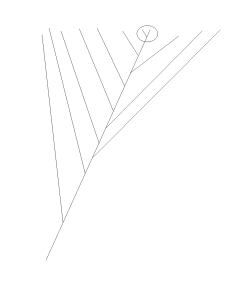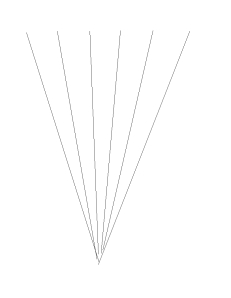So, I mentioned that there’s a problem with the simple distribution of points of divergence. The problem is that by talking strictly about points of divergence we are creating a ‘special’ timeline from which the others are diverging, and are furthermore putting our history into a very special place of being one of two timelines that follow that special timeline to the maximum possible extent. This violates one of my starting principles, so we’ll have to fix it. Right now, we’d get a graph somewhat like this:
When what we want is something more like this:
Now, while it’s certainly possible and easy to straight-out generate a tree of 3, 000-10,000 alternate histories, that’s not really what’s going on in this world and so I want to avoid that. What’s actually going on isn’t the generation of such a small number of alternates, but rather that there exist a nearly infinite number of alternate histories, and we are choosing 3,000-10,000 of them at random (the ones that intersect the habitable portions of the Earth’s surface), and we want that process to generate a tree of this sort rather than a simple fan like this graph:
Which would just be thousands and thousands of culturally alien human timelines. It’s not that I don’t want a fair number of culturally alien human timelines, but I also want a large quantity of ‘traditional’ alternate histories. So instead of looking for a single point of divergence, what I’m going to have to do is divide the relevant parts of history into cohorts (which will probably be done on a logrithmic scale in time), and in each cohort, divide the timelines into a fairly small set of possibilities, according to some kind of Power Law distribution. Then do the same with each group that contains more than one timeline in the next time cohort closer to the present, and so forth. This being a complex algorithm with lots of knobs and fiddly bits that don’t look easy to guess in an emperical/results-based way, it looks like this is Programming Task #2. I’ll then match it to the labels of the cells on the map generate before (while feeling utterly free to fudge the ones in the immediate neighborhood of the prime cell for story purposes), and be ready to go.



Leave a comment